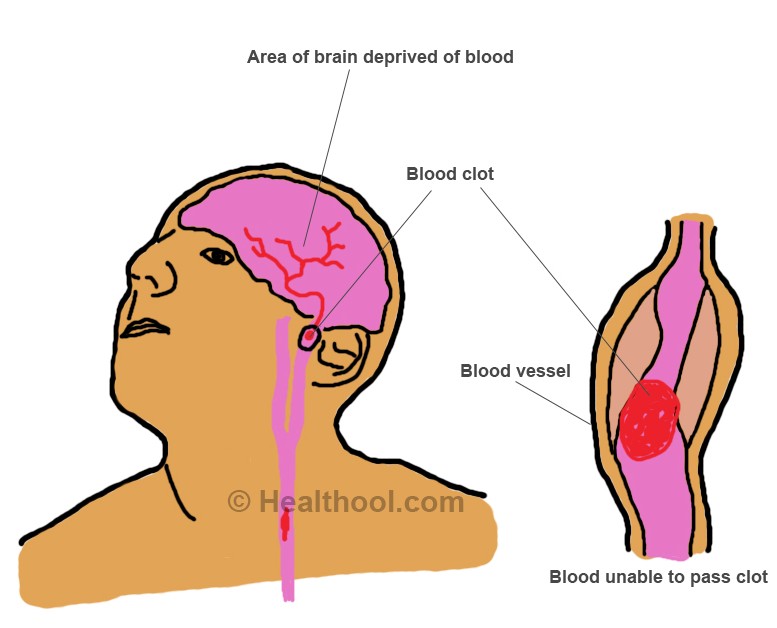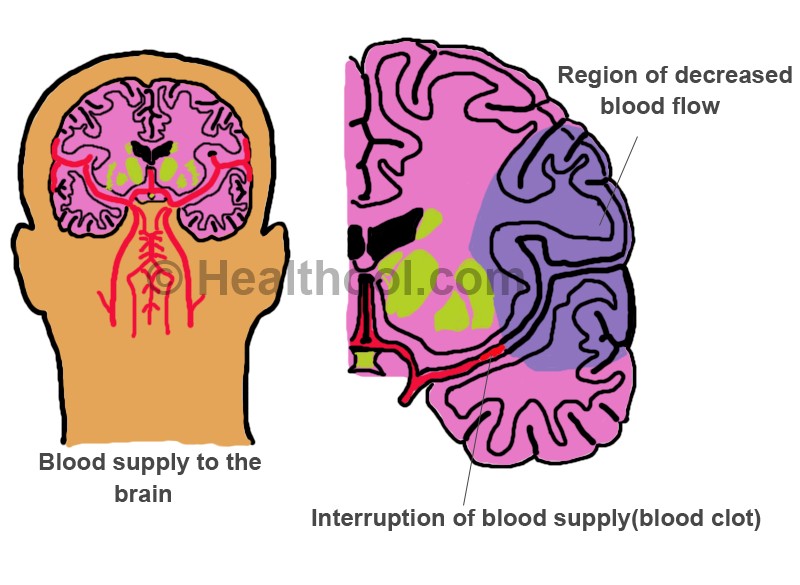Blood Clots in the Brain
Last reviewed by Dr. Raj MD on January 12th, 2022.
In the majority of the cases, the blood clots at the level of the brain are caused by the injuries of the blood vessels in the area. Unfortunately, the symptoms of such problems are quite complex, including a lack of coordination, vertigo, headaches and speech problems.

Picture of Blood clots in the brain : Diagram showing the (i) Area of temporarily blocked blood flow, (ii) Blood clot in the middle cerebral artery and (iii) Blockage in the internal carotid artery.
When a blood clot travels at the level of the brain, reaching a more or less important artery, it can cause a blockage. If this blockage is only temporary, this leads to the appearance of an ischemic stroke (temporary lack of oxygen and nutrients in the area). On the other hand, if the blockage lasts for a prolonged period of time, the artery will compensate by breaking, leading to a hemorrhagic stroke. It goes without saying that latter is more complex, with a more negative prognosis (depending on how extensive the hemorrhage actually is).
Symptoms of Blood Clots in the Brain
These are the most important symptoms that can appear:
- Headaches
- Present on just one side of the head
- Aggravating factors – coughing, sneezing
- The headaches can be so intense, that the patient will avoid physical activity altogether
- Speech problems
- Slurred speech or difficulties speaking
- This occurs in the situation that a blood clot has led to a stroke in the area of language (left side of the brain)
- Confusion
- Longer time to think
- Overall thinking capacity affected
- Feelings of confusion
- Personality changes
- Alteration of personality (manic, depressed)
- Vertigo
- May come and go
- Accompanied by vision problems (temporary blindness)
- Depression
- Often seen in those who have suffered from ischemic strokes
- A blood clot can also restrict the amount of oxygen traveling to the brain, leading to feelings of depression
- Coordination problems
- Coordination difficulties or loss of coordination
- May also lead to the affectation of the fine motor skills (for example, it can be difficult to transfer objects from one hand to the other)
- Seizures
- The blockage caused by the blood clot in a certain area of the brain can lead to seizures, lasting as far as two minutes
- Paralysis
- In the case of stroke, commonly just one side of the body is paralyzed (hemiparalysis)
- The paralyzed part of the body is the opposite from the area of the brain affected by the stroke
- Ischemic attack
- Often considered a less dangerous type of stroke (mini-stroke)
- The blood clot temporarily shuts down the oxygenation of the brain, being relieved in a short period of time (consequences still exist).
Causes of Blood Clots in the Brain

Blood clots in the brain picture 2 : Diagram showing the area of brain deprived of blood, blood vessel and the blood clot.
These are the most common causes that can lead to the appearance of blood clots at the level of the brain:
- Trauma or injury
- Most common areas – head and neck
- Bleeding can occur between the skull and the brain
- The clot appears as a form to stop the bleeding, pressing on the surrounding structures
- The blood clots caused by a traumatic injury can lead to an ischemic stroke
- Blood clot traveling from another part of the body
- If the blood clot travels to the brain, it can cause an embolic stroke (also known as cerebral embolism)
- Can cause damage in other parts of the body before actually reaching the brain
- Atherosclerosis (narrowing + hardening of arteries)
- Increased risk for blood clots in the brain
- Hardened artery → risk of tearing → clot in the damaged area, so as to stop the bleeding → clot taken to the brain through the bloodstream
- Clots can cut off blood flow to the narrowed artery → damage in the area
- Inflammation of a superficial vein
- Increased risk for blood clots in the brain
- Most common cause – trauma or injury of the respective vein
- Inflammation can also appear as a result of bacterial infection
- Damaged area → higher risk of leakage → blood clot formation
- Blood clot can cut off blood supply → damage to adjacent structures
- Oral contraceptives
- Increased risk for the formation of blood clots
- Risk factors include:
- History of blood clots
- Age over 35
- Smoking
- Prolonged usage of oral contraceptives
- Other causes
- Antiphospholipid syndrome
- Hormonal supplements
- Medication administered in breast cancer patients
- Deep vein thrombosis
- Heart problems (arrhythmia, heart attack, cardiac insufficiency)
- Obesity
- Peripheral artery disease
- Anemia (polycythemia vera)
- Pregnancy
- Being bedridden or immobilized.
Treatment for Blood Clots in the Brain

Diagram of Blood clots in the brain – Region of decreased blood flow, Interruption of blood supply (blood clot).
These are the measures of treatment that can be taken:
- Anticoagulants
- Often administered – aspirin
- Purpose – dissolve the clot
- Can also be used for prophylactic purposes (prevent the formation of new clots)
- Antiplatelet agents
- Recommended in patients who have suffered strokes caused by blood clots
- Corticosteroids
- Purpose – anti-inflammatory effect (blood clots in the brain can also cause inflammation in the surrounding area)
- Surgical intervention
- Surgical removal of the blood clot at the level of the brain (embolectomy); more serious cases – incision made into the skull, in order to remove the clot
- May be performed in order to remove the plaque gathered at the level of the arteries – surgery with prophylactic purpose (prevent the formation of blood clots)
- Carotid endarterectomy – recommended for those who have been diagnosed with atherosclerosis
- Insertion of tissue plasminogen activator
- This is performed at the level of a vein
- Recommended for the patients who are at risk of developing new clots
- Thanks to this activator, the medication meant to dissolve the drugs is administered directly into the bloodstream (thus preventing the blood clots from forming and causing a stroke at the level of the brain)
- Other
- Speech therapy, occupational therapy and physical therapy – recommended to those who have suffered a stroke (rehabilitation period)
- Psychotherapy – helps patients deal with the feelings of depression, anger and frustration (caused by the loss of functionality).
When are you facing an Emergency situation?
There are certain symptoms that might guide you in seeking out emergency medical assistance (most likely, you are experiencing a stroke or a heart attack). If you have difficulties breathing, pain or tightness in the chest, with the pain extending to the shoulder or entire arm, you should seek out emergency medical assistance. The same goes for the following: increased pulse or heartbeat, sudden weakness or numbness on one side of the body. If you notice other people suddenly experiencing difficult speech or you see them not being able to understand you, these might also represent signs of stroke.
Prevention
It is possible to reduce the risk of blood clots and stroke by leading a healthy lifestyle. You need to become more active, enjoying daily physical activity and avoiding periods of prolonged seating. The more active you are, the more reduced the risk of stroke is going to be. At the same time, you have to maintain a healthy diet, one that includes plenty of fresh fruits and vegetables. In this way, you will reduce the risk of atherosclerosis and, subsequently, the one of blood clot formation.